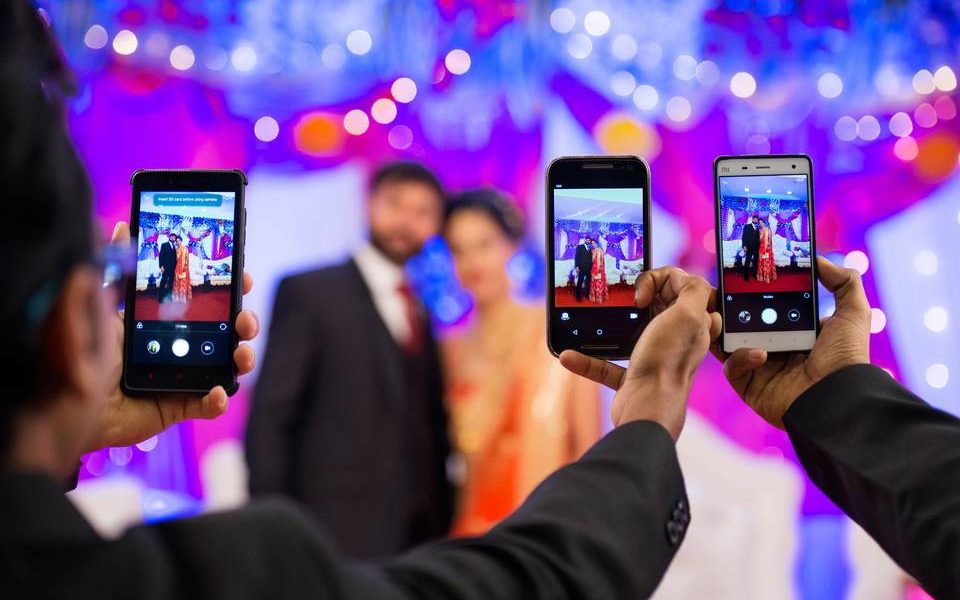The traditional Nikkah, once the heart of Kashmiri weddings, is now taking a backseat to more elaborate celebrations.
“Shaadi aysi karo ki chaar log puche, shaddi thi ya award function” (Make your wedding so grand that people ask if it was a wedding or an award function). Such punchlines now characterise Kashmiri weddings on Instagram, marking a departure from the days when weddings were confined to family photo albums.
Every detail, from a bride descending the stairs in a lehenga to the illuminated house, the Nikkah ceremony, and the traditional women’s dance, finds its spotlight on social media. Instagram feeds overflow with videos flaunting Wazwan dishes, lavish flower decorations, and distinctive dry fruit boxes, each crafted uniquely for different weddings. Even the simple meat bags, designed for taking Wazwan dishes home, have undergone a stylish makeover.
The traditional Nikkah, once the heart of Kashmiri weddings, is now taking a backseat to more elaborate celebrations. The shift is evident—from a simple family affair to a spectacle that captivates the attention on social media.
Adding an intriguing layer to this trend is the documentation of even the most sacred acts, such as the bride’s morning prayers and Quran readings. For Hayah, a student of Islamic Studies from Kashmir, this is disconcerting: “Some things like dua and Qur’an recitation are sacred and meant to be directed towards God. It personally strikes me as very odd that these things are posted online.”
Tagging henna designers, makeup artists, and event planners below a bride’s pictures is another trend. It has made weddings more expensive as now you are paying for something which could have been managed more affordably.
For Muskan, a 26-year-old girl from North Kashmir, simplicity is the key. She prioritises a simple Nikkah, emphasising that a big wedding doesn’t guarantee a happy marriage. She suggests, “If you’ve money, there’s no need for a flashy show. Better to maintain a healthy bank balance; it’ll be more useful for the future.”
Adding another layer to this evolving tapestry is the influence of TV dramas and Instagram celebrities, particularly those from Indian or Pakistani shows. New rituals such as bridal entries, chadar ceremonies, and roqa have found their way into Kashmiri weddings, inspired by what is portrayed on the screen. Even Haldi, which wasn’t part of Kashmiri weddings before, is in the mix now. Septuagenarian Khadija from Srinagar’s Habak laments the change: “Back in the day, our weddings in Kashmir had peaceful songs. But now, the music is too loud, and the songs (referring to Punjabi and Hindi songs) are hard to understand. I miss the traditional tunes we used to have.”
Between Tradition and Teasing
In the web of Kashmir’s evolving weddings, Dr. Ahmad from Baramulla provides a stark reality check. Despite his wealth, he chose a simple Nikah of his daughter, bypassing the grand showcase on social media. “We kept it simple,” he shared. Yet, beyond the simplicity he sought, a lingering challenge emerged. Over a year since the marriage, persistent teasing from relatives serves as a reminder that societal expectations run deep.
“If we opt for grand weddings and share them on social media, we often encounter negative remarks, deeming it as a show of extravagance and against Islamic principles,” Dr. Ahmad continued. “On the flip side, choosing a modest Nikah ceremony is met with criticism too, insinuating that despite having the means, we are portraying an image of a shikaslad (downtrodden).”
Dr. Ahmad’s experience unveils a powerful truth: the potential for change lies not just in resisting showmanship but, crucially, in challenging established norms. “The change should come from the groom’s family because, as I see it, if the girl’s family tries, the teasing can last forever,” he added.
Keeping It Simple
In the heart of the Kashmir Valley, where over 93.6 percent of the population follows the Islamic faith, a noticeable gap emerges between evolving wedding trends and the simplicity advocated by the last prophet of Islam: “The best marriage is that upon which the least trouble and expense are bestowed.” However, as Kashmir adapts to changing customs, the rising financial burden poses challenges for those with limited means.
According to Asar Lone, a PhD student of Sociology at JNU from Kashmir, “This mindset overlooks our social responsibilities.” She highlights that Kashmiri weddings are more than the union of two individuals—they’re a public showcase of a family’s economic status. Asar points out, “It is not uncommon for families in Kashmir to spend years collecting money for a socially respectable wedding.”
A survey by Tehreeki Falahul Muslimeen in April 2020 revealed that over 50,000 girls in Kashmir had surpassed the acceptable marriage age. Initially planning to support a hundred unmarried poor girls, the NGO discovered a larger issue—thousands of women from underprivileged families facing new social challenges.
Despite the discouragement of dowries in Kashmiri weddings, the overall expenditure has skyrocketed. The ceremonies go on for days and each extravagant event costs millions of rupees. The famed Wazwan, boasting a plethora of dishes from Rista and Kebab to Tabak Maaz and Rogan Josh, demands considerable resources and it isn’t a one-time affair.
These dishes grace various wedding events like Mahraz-saal (feast for the groom by the bride’s family), Walima (a feast by the groom’s family for their relatives and the bride’s close family), Phiri Saal (the bride’s family inviting the couple and the groom’s family for a meal at their house), and, of course, the main reception in both the bride and groom’s families on the wedding day. Additionally, the exchange of gold, clothes, and other gifts from both sides becomes a compulsory part of the ceremony.
Asar also points to the Wartav system as part of the problem, making it challenging to focus on the essence of the union rather than the monetary part. “The Wartav system is like a cycle. It makes it impossible to concentrate on the heart of marriage,” she emphasises.
The Wartav system is a compulsory tradition where all guests and relatives are required to provide monetary gifts to the bride and groom. This practice is obligatory rather than voluntary. The distinctive feature of this system is its reciprocity: when one family gives a certain amount of money as a gift during a wedding, the expectation is that the receiving family will reciprocate with a comparable amount during their own future events. This creates a structured and mandatory cycle of giving and receiving, turning the act of presenting money into a formalised and expected component of Kashmiri wedding customs.
“Islam calls for simple weddings and it is unfortunate that we often forget Islamic rulings on weddings because we are so immersed in culture,” said Mufti Nizam-ul -Haq Nadvi based in North Kashmir, adding that in Islam, marriage is simply taking the willing girl, with her family’s approval, to the groom’s home and the girl’s family bears no expenses in this.
He concluded, “If we make the weddings easy, it will close the paths to fornication. And the refinement and modesty of the social atmosphere will be enhanced.”








